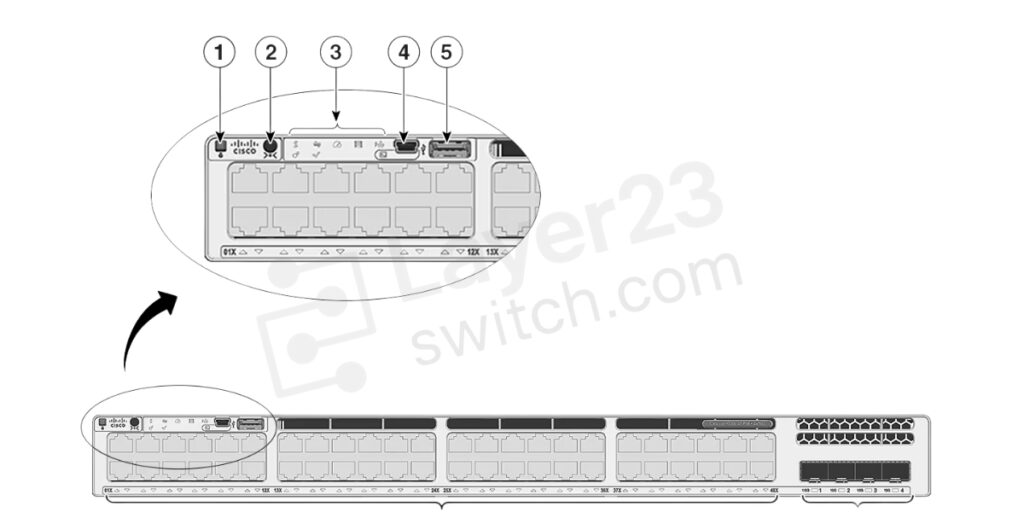Your cart is currently empty!
If you need to format usb flash drive for cisco switches 9300, you’re not alone. Many network engineers run into issues when a USB drive isn’t recognized by the switch during software upgrades, configuration backups, or log transfers. The main reason? The file system or drive size may not be compatible with Cisco requirements.

This step-by-step guide explains exactly how to format your USB flash drive for Cisco Catalyst 9300 switches, including best practices for file systems, supported capacities, CLI commands, and troubleshooting tips to ensure your device is detected every time.
Why Does USB Format Matter on Cisco Switches?
Not all USB drives work with Cisco. The Catalyst 9300 expects your flash drive to be formatted as FAT16 or FAT32 (NTFS and exFAT won’t work). For best results, use a drive of 2GB–32GB. Too large or fancy a drive can cause detection problems.
Engineer’s Tip: Stick to USB 2.0, branded drives (SanDisk, Kingston, etc). Avoid USB 3.0 “super” sticks.
Cisco USB File System Compatibility Table
When selecting or formatting a USB flash drive for your Cisco Catalyst switch, it’s critical to choose the right file system. Here’s a quick reference:
|
Cisco Switch Model |
Supported File Systems |
Typical Use Case |
Notes |
|---|---|---|---|
|
Catalyst 9300, 9200, 3850 |
FAT16, FAT32 |
USB flash for config, IOS images |
exFAT, NTFS NOT supported |
|
Catalyst 9500, 9400, 9600 |
FAT16, FAT32 |
USB flash for config, IOS images |
Some modules support EXT2/EXT3/EXT4 SSDs |
|
Industrial Ethernet (IE 3000, 4000) |
FAT16, FAT32 |
Rugged USB storage |
Avoid high-capacity or USB 3.0 sticks |
|
Nexus 9K/3K (newer NX-OS) |
FAT16, FAT32, EXT2, EXT3 |
Larger SSD or multi-use storage |
Check specific NX-OS version |
|
Cisco ISR/ASR Routers |
FAT16, FAT32 |
IOS backup/restore |
NTFS, exFAT not supported |
|
All Models |
NTFS, exFAT |
Not Supported |
Formatting may cause recognition errors |
|
New Catalyst with SSD Module |
EXT4 |
Large log/archive storage |
Use only for Cisco SSD (not USB stick) |
Quick Reference & Pro Tips
- Not Recognized? Reformat as FAT32 on a PC/Mac, avoid NTFS or exFAT.
- Best Practice: Always use FAT32 for USB flash drives.
- Capacity Tip: For most models, keep USB drives ≤32GB for maximum compatibility.
Check the file system directly:
Switch# show file systemsLook for the “Type” column (e.g., disk, fatfs, ext4fs).
Step 1: Format USB Flash Drive for Cisco Switches on a Computer
Windows:
- Insert your USB stick.
- Open “This PC,” right-click the drive, select “Format.”
- Choose FAT32 as the file system.
- (Optionally name the drive.)
- Tick “Quick Format” and start.
- Safely eject.
macOS:
- Click “Erase.”
- Insert the USB drive.
- Open “Disk Utility.”
- Select the drive > “Erase.”
- Choose MS-DOS (FAT), scheme: Master Boot Record.
Step 2: Plug the USB into Your Cisco 9300
- Insert the formatted USB into the switch’s front panel USB port.(5)
- Wait 10–20 seconds for auto-detection.
Step 3: Check if the Switch Recognizes Your USB
Check file systems:
Switch# show file systemsLook for usbflash0: in the list.
List files:
Switch# dir usbflash0:If you see your files, you’re good to go!
Still not showing up?
Run:
Switch# show logging | include usbUnplug, reinsert, or try a different USB stick (preferably <32GB, FAT32).
Step 4: Format USB Flash Drive On Cisco Switches 9300 (Optional)
If you need to reformat the drive on the switch:
Switch# format usbflash0:
Format operation may take a while. Continue? [confirm]
Format operation completed successfully.This will erase all data. Confirm when prompted.
Step 5: Use Your USB for Backups, Upgrades, and More
Copy running config to USB:
Switch# copy running-config usbflash0:backup-config.txtCopy IOS image from USB to switch:
Switch# copy usbflash0:c9300-universalk9.17.09.04.SPA.bin flash:List, verify, or remove files as needed.
Step 6: Safely Remove the USB Drive
Before physically unplugging, always run:
Switch# remove usbflash0:Wait for the message: “Remove the USB device now.”
Troubleshooting: When USB Still Won’t Work
USB not detected?
- Reformat as FAT32.
- Use a smaller drive (2GB, 8GB, or 16GB often work best).
- Try a different USB port (if available).
- Reboot the switch if possible.
Read/Write errors?
- Make sure you’re not using exFAT or NTFS.
- Use a reputable USB brand.
Copy operation fails?
- Check file permissions.
- Ensure the file isn’t too large for the drive’s format (FAT32 has a 4GB limit per file).
View USB Events in Log:
Switch# show logging | include usbCheck Hardware Status:
Switch# show hw-module usbflash0 statusIf “not present,” try another drive or port.
Quick Reference Table
|
Action |
Command/Tip |
|---|---|
|
Check USB detected |
|
|
List USB contents |
|
|
Format USB (on switch) |
|
|
Backup config to USB |
|
|
Copy file from USB |
|
|
Safely remove USB |
|
|
See USB logs |
|
